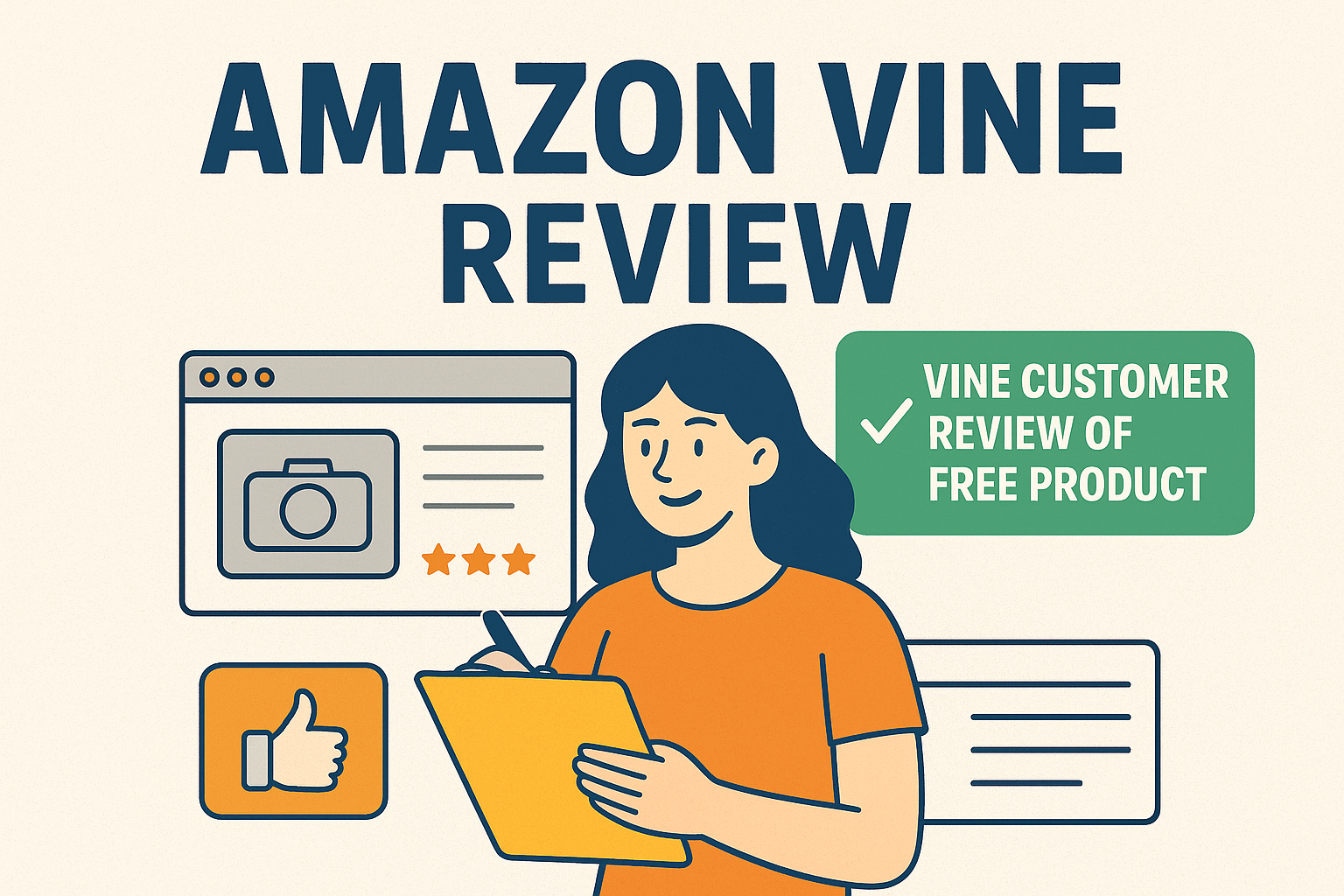Address
304 North Cardinal St.
Dorchester Center, MA 02124
Work Hours
Monday to Friday: 7AM - 7PM
Weekend: 10AM - 5PM

In today’s competitive e-commerce landscape, product reviews are critical for conversion and trust. Among Amazon’s review mechanisms, the Amazon Vine Review Program stands out as one of the most authentic, transparent, and effective ways to generate early product feedback.
This guide provides an expert overview of what the Amazon Vine program is, how it works, who can join, and how to use it strategically to boost credibility, SEO, and sales.
The Amazon Vine Program is an invitation-only initiative designed to generate honest, detailed reviews from top reviewers on Amazon, known as Vine Voices.
Brands and sellers who participate can submit eligible products to the program. Amazon then sends these products free of charge to selected Vine reviewers, who test and provide unbiased feedback.
Each review is published on the product page with a special badge labeled “Vine Customer Review of Free Product.”This ensures transparency, letting shoppers know the reviewer received the item through Amazon but was not influenced by the brand.
Unlike other review programs, Vine is officially approved by Amazon, making it the safest and most credible way to gain early reviews.
Launching a new product with no reviews can be daunting. Vine reviews help build immediate credibility by adding legitimate customer opinions from trusted reviewers. This accelerates buyer confidence and improves conversion rates.
According to Jungle Scout, listings with five or more Vine reviews see up to 30% higher conversion rates in the first 90 days after launch.
Amazon’s A9 algorithm favors listings with fresh, high-quality reviews. Since Vine reviews are detailed and keyword-rich, they can help your product rank better in organic search results — especially when combined with optimized titles and bullet points.
Vine reviewers often leave constructive, in-depth feedback, helping sellers identify potential issues. These insights can drive improvements in design, packaging, or functionality before mass scaling.
Not all sellers or products are eligible for Amazon Vine. To enroll, you must meet the following criteria:
In 2025, the Amazon Vine enrollment fee in the U.S. is approximately $200 per parent ASIN, charged once reviews are published.
Navigate to Seller Central → Advertising → Vine and select eligible ASINs. Submit your product for enrollment.
Amazon ships your product to Vine Voices at no cost to them. You can’t choose who receives it — reviewers are matched based on category expertise.
Vine Voices test the product and write honest, unbiased reviews. Sellers are not allowed to contact or influence them.
Reviews appear publicly with the Vine badge, contributing to your total review count and product rating.
Track results using Seller Central dashboards, Brand Analytics, or third-party tools like Helium10 and Jungle Scout. Measure review volume, star distribution, and sales impact.
A small brand launched an air purifier through Vine. Within two weeks, it earned 10 Vine reviews averaging 4.6 stars. One reviewer wrote:
“It removed pet odors effectively, but the fan at high speed was louder than expected.”
The brand used this feedback to update packaging and clarify noise levels, improving transparency and reducing future complaints.
A new Bluetooth speaker received 12 Vine reviews (including video content) within one month. The product’s click-through rate rose 42%, and its search rank improved from page 6 to page 2 for “portable waterproof speaker.”
A cosmetics brand got several 2-star Vine reviews criticizing fragrance intensity. The company reformulated the product and launched a fragrance-free version that became a bestseller — proving that even negative Vine reviews can drive innovation.
Only enroll products that have passed internal testing and quality assurance. Poor-quality products can receive damaging reviews that harm early sales.
Make sure your titles, bullet points, and A+ content are perfect. Vine reviewers are more likely to engage with clear, informative listings.
Allocate enough stock for Vine reviewers while maintaining availability for real customers.
Use review feedback to identify improvement opportunities. Recurrent issues (e.g., “battery life too short”) should inform product updates.
After Vine reviews go live, continue using Amazon’s “Request a Review” button or post-purchase emails to gather organic feedback.
Track:
While you cannot contact Vine reviewers directly, you may publicly comment on reviews — thanking users or clarifying product details demonstrates transparency and professionalism.
To gauge Vine’s effectiveness, measure the following KPIs:
In most cases, products with 10+ Vine reviews achieve a 15–25% increase in sales velocity within 45 days post-launch.
As Amazon tightens policies on fake reviews, the Vine Program continues to grow in importance. Future updates may include:
With Amazon’s increasing focus on transparency, Vine will remain the cornerstone of credible product review generation.
The Amazon Vine Review program offers a rare balance of authenticity and impact. It empowers sellers to gather transparent, data-driven feedback from top reviewers, building a foundation of trust and visibility.
Used strategically, Vine can:
However, success requires preparation and a quality-first mindset. Treat Vine as both a marketing accelerator and a learning tool, and it will reward you with insights, credibility, and growth.